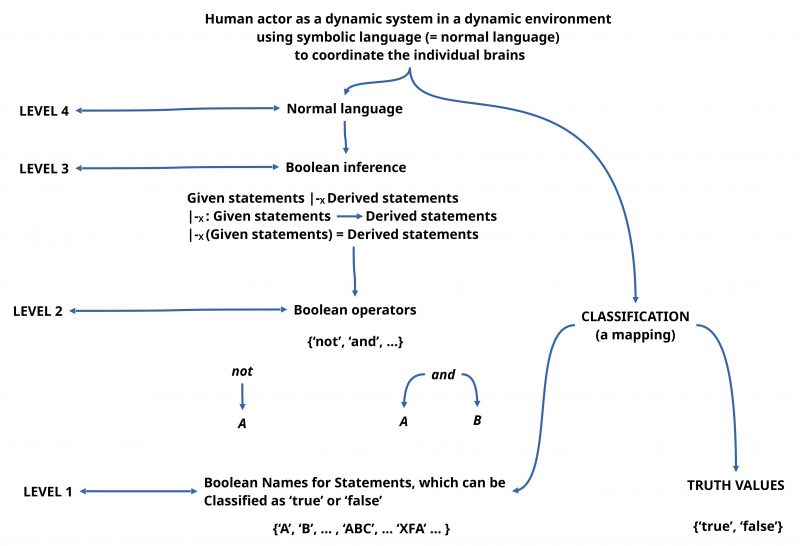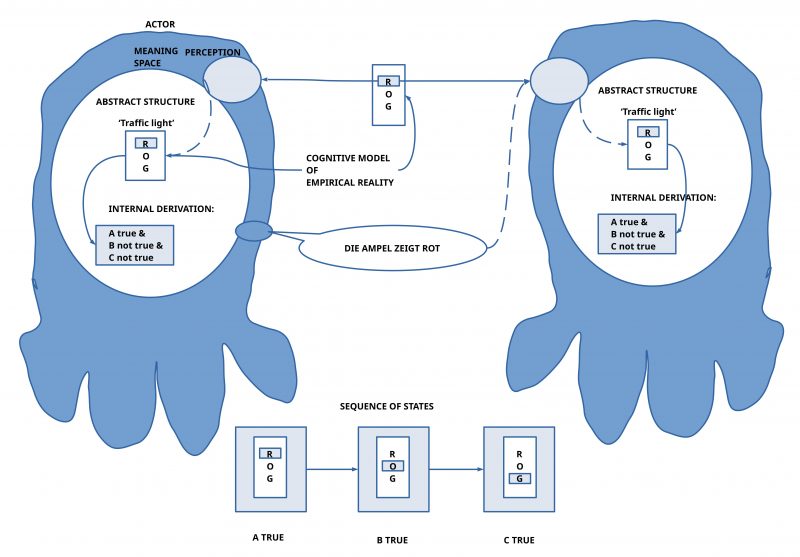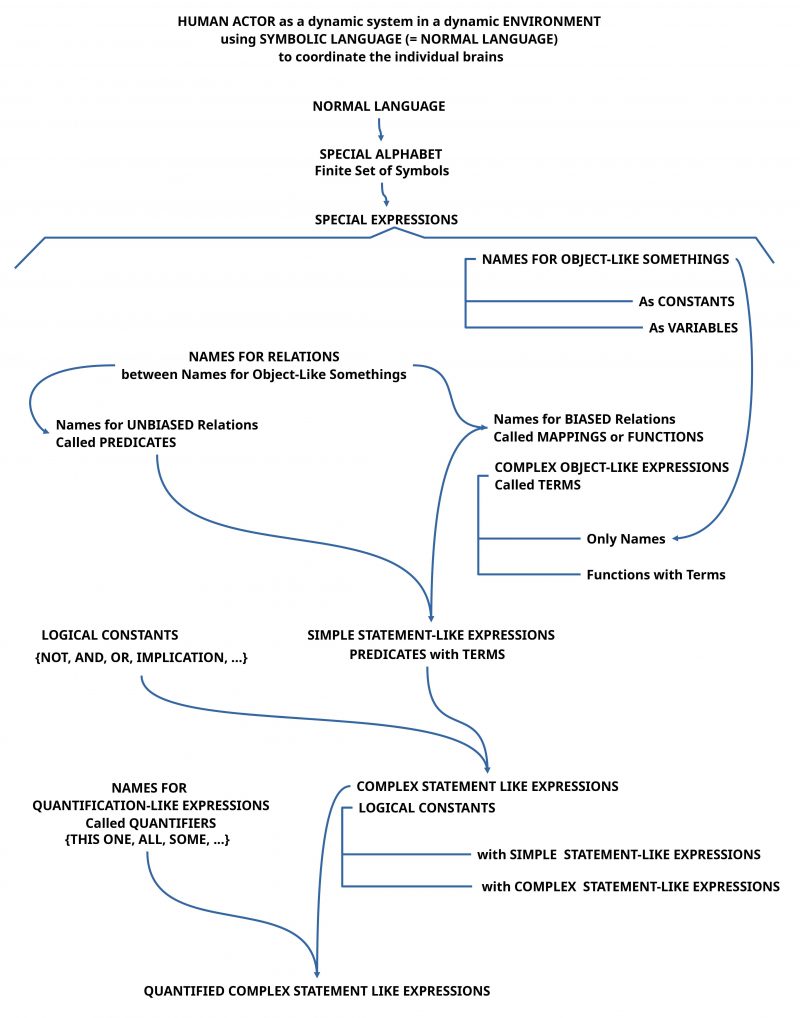eJournal: uffmm.org
ISSN 2567-6458, 19.August 2022 – 19 August 2022
Email: info@uffmm.org
Author: Gerd Doeben-Henisch
Email: gerd@doeben-henisch.de
CONTEXT
This text is part of the subject COMMON SCIENCE as Sustainable Applied Empirical Theory, besides ENGINEERING, in a SOCIETY. It is a preliminary version, which is intended to become part of a book.
True Statements
From the section about Boolean Logic we know, that there can be expressions called ‘statements’ which can be classified as being ‘true’ or ‘false’ without describing what ‘true’ or ‘false’ means. An ‘interpretation’ of a ‘possible meaning’ of the expressions ‘true’/’false’ is a property of the human actor dealing with these statements. We as human speakers ‘know’ by ‘experience’, that the classification of an expression as being ‘true’ or not depends from our ‘interpretation’ of the expression ‘A’ whereby the interpretation activates a ‘known meaning’ which can be related so some ‘assumed world of references’. Thus the usage of Boolean logic is a way of ‘short, condensed notation’ of a possible high complex ‘knowledge’ of the human actor using this notation. Without this assumed knowledge of the human user the notation makes no sense.
In the case of predicate logic the situation is similar, but also different. Predicate logic offers also a notation for expressions called statements which possibly can be classified as being ‘true’ or ‘false’, but in the case of predicate logic these notations are not only ‘names’ of some expressions but they show a minimal ‘expression-inherent structure’.
Figure 4 shows that the ‘minimal format’ of a predicate logic expression called statement includes at least one ‘predicate’ and at least one ‘term’, where the term is minimally represented by a ‘name’ of an ‘object-like something’, and this name is a ‘constant’. An expression is called a ‘constant’ when it is related to a ‘known reference’, which can be related to something concrete, which gives a human actor the possibility to ‘decide’ that there ‘exists’ an ‘observable something’ which can be understood as an ‘instance’ of the ‘known reference’. Thus one can see that in the case of predicate logic too one has to assume a sufficient ‘knowledge’ inside the human actor which enables a sufficient ‘interpretation’ along with the possibility to ‘decide’ whether this ‘name’ is a constant or not.
(Example 1) IS-RED(traffic-light-number-111)
Example 1 shows an example of a simple statement in a predicate logic format with the term ‘traffic-light-number-111’ as a name used as a constant pointing to some assumed decidable object-like something located somewhere in the city related to the predicate expression ‘IS-RED’ with the possible meaning of ‘showing the color red’.
Such an expression with an interpretable predicate expression as well an interpretable name as term can be classified as being ‘true’ if the ‘known meaning’ of this expression, which is assumed within an interpretation, can be related to some ‘observable object-like something’ which ‘matches’ the properties of the known meaning. In this sense the expression of Example 1 can be understood as a ‘notation’ which can be associated with a known meaning by interpretation, which in turn can be ‘verified’ or ‘falsified’, or not. In the last ‘undecidable case’ either there is no ‘observable instance’ available or there is no ‘clear knowledge’ available.
The expressions used here like ‘known meaning’ or ‘object-like something’ or ‘interpretation’ (and others) are not part of predicate logic itself but belong to the ‘meta theory of logic’ — short: meta-logic — which is rooted in the ‘general everyday knowledge’, which has to be assumed as ‘general condition’ for any special thinking. Either it is there and ‘works’ or not. If not, the human actors have no chance to discuss these topics in some way. This kind of ‘primary knowledge’ can be compared to the case of the ‘body’ and therein the ‘brain’ as a ‘something given’, which enables certain real processes which you can ‘use’ by ‘living these’, but without brain or body you are simply ‘not there’. Take it or leave it. If you ‘take it’ then you can do something, e.g. you can use a language associated with some ‘known meaning’ which enables you to ‘relate’ language expressions to ‘something else’ functioning as ‘reference’.
Another more complex format of a predicate logic statement is one where more than one simple predicate occurs:
(Example 2) IS-RED(traffic-light-number-111) AND NOT(IS-ORANGE(traffic-light-number-111)) AND NOT(IS-GREEN(traffic-light-number-111))
In this simple example do occur three simple predicates ‘IS-RED’, ‘IS-ORANGE’, and ‘IS-GREEN’, all related to the object name ‘traffic-light-number-111’, and logical expressions like ‘NOT’ and ‘AND’. The logical expression ‘NOT’ turns the meaning of an expression to the opposite: thus the expression ‘NOT(IS-ORANGE(traffic-light-number-111))’ generates the meaning that the object ‘traffic-light-number-111’ does not show the color ‘orange’ (leaving it undefined, what it could mean not to be ‘orange’! The space of possible other meanings is inherently ‘fuzzy’ and can be ‘large’) . The logic expression ‘AND’ generates a ‘compound meaning’ like ‘IS-RED(traffic-light-number-111) AND NOT(IS-ORANGE(traffic-light-number-111))’. This compound statement generates the known meaning, that the object ‘traffic-light-number-111’ shows the read light and at the same time ‘not’ the orange light. If this is the observable case, then this compound statement would be classified as ‘decidable true’, otherwise not.
If one would use within predicate logic expressions not ‘constants’ like ‘names’ but ‘variables’, then the situation changes.
(Example 3) IS-RED(x) AND NOT(IS-ORANGE(y)) AND NOT(IS-GREEN(z))
A ‘variable’ as such has no known ‘meaning’ and therefore will never be able to be associated with a decidable observable something. Thus to turn a predicate logic expression with variables into a real candidate for being classified as ‘true’ or ‘false’ (or undefined), one has to offer a procedure how to replace the variables by expressions, which can become ‘truth candidates’. A common format for such a procedure is the ‘replacement’ (often called ‘substitution’) of the expression called ‘variable’ by an expression called ‘constant’ like ‘x’ will be replaced by ‘traffic-light-number-111’, written: (x/traffic-light-number-111).
In case of predicate logic there exists one more ‘formal element’ to modify the possible meaning: Quantifiers! To say ‘ALL (x)’ or ‘ONE (x)’ or ‘SOME (x)’ or ‘EXACT n (X)’ and the like gives some ‘clue’, to the assumed ‘number’ of object-like somethings which have to be shown to ‘be there’ in a ‘decidable manner’.
Thus it makes a difference whether one writes ‘ALL(x)’ in the case of ‘IS-RED(x) AND NOT(IS-ORANGE(y))’ or ‘ALL(x,y)’. If one in the first case ‘ALL(x)’ replaces (x/traffic-light-number-112) then one derives the expression ‘IS-RED(traffic-light-number-111) AND NOT(IS-ORANGE(y))’, where the variable ‘y’ is still undefined. In the second case with ‘ALL(x,y)’ one will derive by (x/traffic-light-number-112) and (y/traffic-light-number-113) the expression ‘IS-RED(traffic-light-number-111) AND NOT(IS-ORANGE(traffic-light-number-113))’; all variables have been replaced.
In case of Example 3, where the used variable {x,y,z} are as expressions ‘different’, one can speak potentially about three different traffic lights using the replacements (x/traffic-light-number-111), (y/traffic-light-number-112), (z/traffic-light-number-113):
(Example 3.1) IS-RED(traffic-light-number-111) AND NOT(IS-ORANGE(traffic-light-number-112)) AND NOT(IS-GREEN(traffic-light-number-113)
If these different traffic lights would be distributed at different places in the city then it could become more and more difficult if not even infeasable, to observe these objects in a decidable way simultaneously. To use technological means to solve the problem can work ‘in principle’ by using such ‘technological means’, but then the technological means have to be ‘proven’ to work ‘correctly’ (they have to be ‘certified’). Who can and will do this?
This example demonstrates that the formal status of an expression — having constants instead of variables — enables ‘principally’ a decision procedure between the actors, but by ‘practical conditions’ this ‘formal possibility’ can often not be resolved in the domain of ‘real usage’.
Such a case of ‘theoretical decidable’ but ‘practical undecidable’ is also given if one uses the quantifier ‘ALL (x, …)’ where the number of ‘possible real candidates’ is by practical reasons not really decidable, e.g. ‘All human persons are at 10:00 a.m. the upcoming Monday not hungry’, written as ‘ALL (x) HUMAN-PERSON(x) AND (NOT(IS-HUNGRY(x)) AND DATE(next(Monday)) AND CLOCK(10, a.m.)’. In this example ‘Monday’ is related to a ‘calendar’ and ‘next()’ is a function mapping the actual day in the calendar to the next available Monday. The possible real instances of the variable ‘x’ are assumed as ‘all living human persons on the planet earth 17.July 2022’. Actually we have no measurement procedure to decide all these statements.
If one uses the quantifier ‘ONE()’, then one introduces a ‘restriction’ to the umber of possible instances where the whole number of possible real candidates shall be ‘one’:
(Example 3.2) ONE(x) IS-RED(x) AND NOT(IS-ORANGE(x)) AND NOT(IS-GREEN(x))
The ‘meaning of the quantifier ‘ONE()’ is assumed here as ‘There must exist one object-like something, which is a candidate for the known meaning’.
If we assume the replacement (x/traffic-light-number-111) then we get the expression
(Example 3.2.1) ONE(x/traffic-light-number-111)(IS-READ(traffic-light-number-111) AND NOT(IS-ORANGE(traffic-light-number-111)) AND NOT(IS-GREEN(traffic-light-number-111))
This expression can become classified as ‘true’ observing the traffic light in place.
The final aspect of predicate logic expressions — which we already have used in the ‘next Monday’ example — are the ‘terms’ in predicate logic. A term is in the simple case (i) only one variable or a constant replacing the variable, or (ii) a ‘function’ — often called ‘operator’ — with some ‘arguments’ like ‘add(1,3)’ or ‘multiply(4,7)’ or ‘father-of(John)’ or ‘phone-number-of(Bill)’ or the like. A function is a ‘biased relation’ mapping some object-like things to other object-like things. Because a certain customer of a phone-company has usually exactly one phone-number one can resolve ‘phone-number-of(Bill)’ by looking to the list of phone-numbers of this company (or you know the number already). The expression ‘father-of()’ works similarly. ‘Multiplying’ two numbers is described in a part of mathematics giving strict rules how to multiply two numbers, thus following these rules you will get ‘one number’ as the ‘result’ of this operation like ‘multiply(4,7)=28’. Because a function applied to object-like somethings produces again an object-like something the function stays as a term in the realm of object-like somethings. Thus in an expression like ‘ONE(x) FATHER(father-of(x))’ one uses the function ‘father-of()’ to denote that one object-like something which is the father of x to make the statement, that this ‘father-of(x)’ has the property of being a ‘father’ written as ‘FATHER()’. While the function ‘father-of()’ determines exactly one biological object-like something the predicate ‘FATHER()’ can be applied to many different object-like somethings, e.g. ‘ONE(x) ONE(y) FATHER(father-of(x)) AND FATHER(father-of(y))’ , replacing (x/Bill), (y/Susan) then ‘FATHER(father-of(Bill)) AND FATHER(father-of(Susan))’ the function father-of() generates two different object-like somethings but the predicate FATHER() can be applied to both of them.
— draft version —



